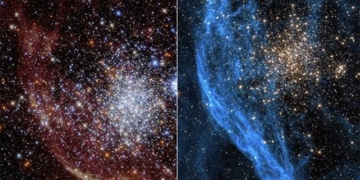The “super monster” Megalodon is considered one of the most terrifying creatures in the world due to its gigantic size. However, scientists have recently made new discoveries about it.
The prehistoric “super monster” Megalodon has always been regarded as one of the most fearsome creatures ever known to the world.
Previous research findings suggested that this species could grow up to 20 meters long. However, the scientific community has yet to reach a consensus on the size of Megalodon, as their studies have been based solely on the scant fossils available from this shark, namely its teeth and vertebrae.

Illustration of a Megalodon eating a smaller great white shark – (Image: BARIS-OZER/GETTY)
They speculate that Megalodon must have had a colossal body shape similar to its modern-day descendants: the great white shark.
In a research report published in the journal Palaeontologia Electronica on January 22, an international team of scientists suggested that Megalodon might resemble the mako shark – a species known for its sleek body.
Biologist Phillip Sternes from the University of California (USA) stated: “Our team re-examined the fossil records and discovered that Megalodon was leaner than we previously thought.”
“This creature could still be a formidable predator at the top of the ancient marine food chain, but its behavior may differ based on what we have newly uncovered about its body,” he emphasized.
Paleontologist Kenshu Shimada from DePaul University in Chicago (USA) – a co-author of the study – also suggested that Megalodon “might not be a strong swimmer” compared to the great white shark.
Moreover, the hunting needs of Megalodon might be less due to its longer digestive system. This could also shed light on the mystery of Megalodon’s extinction.
Previously, scientists hypothesized that this shark species gradually died out due to a decrease in prey availability. However, updated images of this species’ body indicate another potential culprit.
“I believe there is a combination of many factors leading to extinction, but one of them could be the emergence of the great white shark, a creature that can move more agilely and has become an even better predator than Megalodon,” Sternes noted.


















































